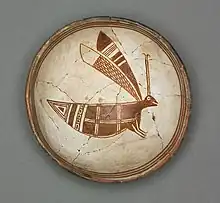
Grasshopper Pueblo, sometimes called Grasshopper Ruin, was a populated place from 1275 to 1400 CE[1] at what is now Fort Apache Indian Reservation, about 10 mi (16 km) west of Cibecue in east-central Arizona in the United States. The settlement was a multicultural community[1] that housed people from Puebloan, Mogollon and possibly Salado[2] backgrounds, et al.[3] Initial excavations of the "extremely large" masonry pueblo found 500 rooms, two smaller pueblos of 20 to 30 rooms, multiple kivas, hearths, courtyards, refuse dumps, multiple cemeteries, grave goods, and animal burials.[4]
There are two explanations for the site's name: one says that the Pueblo is named for a "lame Apache woman whom the Indians called 'Naz-chug-gee' (Grasshopper)" and another story says it's simply a place rich in grasshoppers.[5] The buildings are located in a mountain meadow at an estimated elevation of 5,922 feet (1,805 m) above sea level;[6] Salt River Draw runs through the middle of settlement, suggesting the waterway was used as a natural boundary between neighborhoods.[1] The roof of the Great Kiva, built c. 1330[1] and excavated 1964–67, was found to have been supported by 12 "massive" juniper posts.[4] There is evidence of that some of the pueblo buildings had a second story.[4] Parrot and macaw skeletons found at the site are evidence of a exotic-animal trade between the Southwestern region of North America and Central America.[7][8] Turquoise was likely exchanged for the macaws and other Mesoamerican trade goods, including copper bells.[5]
The University of Arizona Archaeological Field School was established at the site in 1963.[4] Anonymous donations funded the construction of a kitchen, classroom and student housing at the site (which was leased from the White Mountain Apache tribe)[9] in support of annual summer excavation work. LBJ's daughter Lynda Bird Johnson attended the Grasshopper Field School as a "special student" for two weeks in 1965.[4] Over the decades, researchers studied the site's sediments, geology and lithic resources, floral and faunal remains, human skeletal remains, and pollen profile,[9] generating "many published papers, nine doctoral dissertations, and two masters' theses."[5] The Field School closed in 1992.[5]
Other notable archeological sites in east-central Arizona include Kinishba, Canyon Creek, Forestdale, Point of Pines, and Vernon.[4]
References
- 1 2 3 4 Riggs, Charles R. (2007). "Architecture and Identity at Grasshopper Pueblo, Arizona". Journal of Anthropological Research. 63 (4): 489–513. doi:10.3998/jar.0521004.0063.402. ISSN 0091-7710. JSTOR 20479462. S2CID 143877804.
- ↑ Mayro, Linda L.; Whittlesey, Stephanie M.; Reid, J. Jefferson (January 1976). "Observations on the Salado Presence at Grasshopper Pueblo". KIVA. 42 (1): 85–94. doi:10.1080/00231940.1976.11757866. ISSN 0023-1940.
- ↑ Olsen, John W. (1990). Vertebrate Faunal Remains from Grasshopper Pueblo, Arizona. Ann Arbor, MI: U OF M MUSEUM ANTHRO ARCHAEOLOGY. doi:10.3998/mpub.11396289. ISBN 978-0-915703-21-0.
- 1 2 3 4 5 6 Thompson, Raymond H.; Longacre, William A. (1966). "The University of Arizona Archaeological Field School at Grasshopper, East Central Arizona". Kiva. 31 (4): 255–275. doi:10.1080/00231940.1966.11760538. ISSN 0023-1940. JSTOR 30247567.
- 1 2 3 4 Reyman, J.E. (2001). "Book Reviews: Grasshopper Pueblo. A Story of Archaeology and Ancient Life". Bulletin of the History of Archaeology. 11 (12): 13–16. doi:10.5334/bha.11205.
- ↑ "Feature Detail Report for: Grasshopper". Geographic Names Information System. United States Geological Survey, United States Department of the Interior.
- ↑ Moretti, John A. (2022-09-29). "An ancient Thick-billed Parrot (Rhynchopsitta pachyrhyncha) from southeastern New Mexico with a review of archaeological occurrences in the American Southwest". The Wilson Journal of Ornithology. 134 (3). doi:10.1676/21-00078. ISSN 1559-4491. S2CID 252818553.
- ↑ Olsen, John W. (1990). Vertebrate Faunal Remains from Grasshopper Pueblo, Arizona. University of Michigan Press. doi:10.3998/mpub.11396289. ISBN 978-0-915703-21-0. JSTOR 10.3998/mpub.11396289.
- 1 2 "Multidisciplinary Research at Grasshopper Pueblo Arizona (Book Review)". Southwestern Lore. 50 (1): 22–23. March 1984.
Further reading
- Ezzo, Joseph A. (1993). Human adaptation at Grasshopper Pueblo, Arizona: social and ecological perspectives. International Monographs in Prehistory: Archeological Series. Vol. 4. Ann Arbor, Mich.: Berghahn Books. ISBN 978-1-87962-109-1. OCLC 29184243.
- Reid, J. Jefferson; Whittlesey, Stephanie Michelle (1999). Grasshopper Pueblo : a story of archaeology and ancient life. Tucson: University of Arizona Press. ISBN 0-8165-3316-4. OCLC 606302671.
- Riggs, Charles R. (2011). Architecture of Grasshopper Pueblo. Salt Lake City: University of Utah Press. ISBN 978-0-87480-857-5. OCLC 718450587.